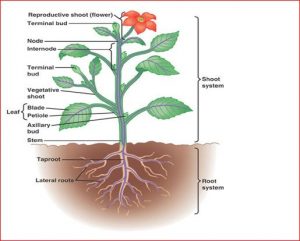Exercises:
I. Correct the following statements and rewrite them in your notebook :
a) Stem absorbs water and minerals from the soil.
b) Leaves hold the plant upright.
c) Roots conduct water to the leaves.
d) The number of petals and sepals in a flower is always equal.
e) If the sepals of a flower are joined together, its petals are also joined together.
f) If the petals of a flower are joined together, then the pistil is joined to the petals.
Ans:
a) Roots absorbs water and minerals from the soil.
b) Stem holds the plant upright.
c) Stem conduct water to the leaves.
d) The number of petals and sepals in a flower is always equal.
e) If the sepals of a flower are joined together, its petals are separate.
f) If the petals of a flower are joined together, then the pistil may or may not be joined to the petal.
2. Draw a) A leaf b) A taproot and c) A flower, you have studied for table 7.3 .
Ans:

3. Can you find a plant in your home or in your neighbourhood, which has a long but weak stem. Write its name. in which category would you classify it.
Ans: Yes, a money plant it is a climber.
4. What is the function of a stem in a plant.
Ans:
i) Stems holds the plant upright.
ii) Stem conduct water to the leaves.
iii) Stem conducts food from leaves to other parts of the plants.
iv) Stem bears leaves, flowers and fruits.
5. Which of the following leaves have reticulate variation. Wheat, Tulsi, Maize, Grass, Coriander (dhania), China rose.
Ans: Tulsi, Coriander, China rose have reticulate variation.
6. If a plant has fibrous root, what type of venetion do its leaves likely to have.
Ans: If a plant has fibrous root its leaves have parallel venetion.
7. If a plant has leaves with reticulate venetion, What kind of roots will it have.
Ans: If a plant has leaves with reticulate venetion, it will have Taproot.
8. Is it possible for you to find out whether a plant has taproot or fibrous roots by look at the impression of its leaf on a sheet of paper.
Ans: Yes, it is possible to find out whether a plant has tap root or fibrous root by looking at the impression of its leaf on a sheet of paper.
9. What are the parts of a flower.
Ans: The parts of a flower are :
a) Petals b) Sepals c) Stamens d) Pistil e) Anther
f) Filament g) Style h) Stigma i) Ovary j) Ovules .
10. Which of the following plants have you seen. Of those that you have seen flowers. Grass, Maize, Wheat, Chilli, Tomato, Tulsi, Pipal, Shinsham, Banyan, Mango, Jamin, Guava, Pomegranate, Papaya, Banana, Lemon, Sugarcane, Potato, Groundnut.
Ans: Chilli, Tomato, Tulsi, Mango, Jamun, Guava, Pomegranate, Papaya, Banana, Lemon, Potato, Groundnut.
11. Name the part of plant which produces food. Name the process.
Ans: Leaves produce food through a process called as Photosynthesis.
12. In which part of a flower, you will find the Ovary.
Ans: Ovary is in the lower most and swollen part of the pistil.
13. Name two plants in which one has joined Sepals and other has separate Sepals.
Ans: Cotton and Tomato plants have joined Sepals. Lily and Jasmine plants have separate Sepals.
Suggested Projects and activities:
1. Names of the plant parts are hidden in the grid. Sepals for them by going up, down or even diagonally forward as well as backward. Have fun.
(Attach the picture from page 65)

